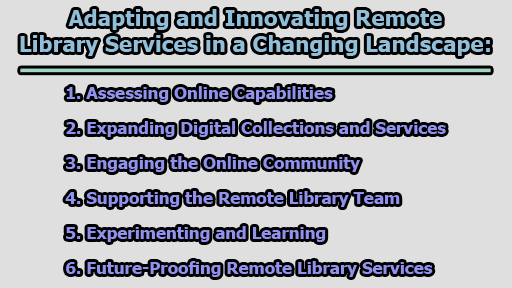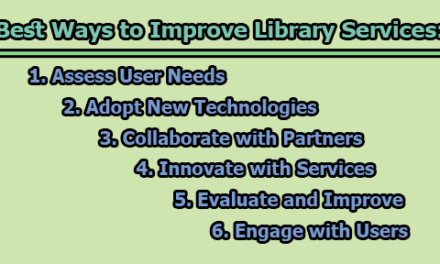Adapting and Innovating Remote Library Services in a Changing Landscape:
In a rapidly evolving digital era, the role of libraries has expanded beyond their physical spaces. The advent of remote library services has proven essential, especially in the face of global challenges like the COVID-19 pandemic. As libraries continue to meet changing needs and expectations, adaptation and innovation become paramount. In this article, we’ll explore a comprehensive approach to adapting and innovating remote library services in a changing landscape, addressing online capabilities, expanding digital collections, engaging the online community, supporting the library team, experimenting and learning, and future-proofing services for a post-pandemic world.
1. Assessing Online Capabilities: Before embarking on any transformative journey, it’s crucial to assess your library’s current online capabilities. A SWOT analysis of digital library resources, platforms, and tools can reveal gaps and areas for improvement. Soliciting feedback from both staff and users can provide valuable insights into how to make online services more accessible and user-friendly. Key questions to consider include:
- How accessible and user-friendly are your online catalog, databases, and e-books?
- How effectively do you communicate and promote your online services to your target audience?
- What are the best practices and standards in your field for online library services?
- What emerging trends and technologies could enhance your online library services?
By addressing these questions, libraries can measure and evaluate the impact and usage of their online services, laying the foundation for future improvements.
2. Expanding Digital Collections and Services: To stay relevant and meet the diverse needs and interests of online users, libraries must expand their digital collections and services. This expansion can encompass various formats and sources of digital content, such as podcasts, webinars, blogs, videos, and social media. Moreover, joining online platforms and networks like Open Access, Creative Commons, and Open Educational Resources can enable the sharing and access of digital content with other institutions.
Additionally, libraries can provide new or enhanced online services, including virtual reference, e-learning, digital literacy, and outreach programs. This broadening of offerings ensures that libraries remain dynamic and in tune with their communities.
3. Engaging the Online Community: Building a sense of community and connection among online users is a critical aspect of remote library services. To achieve this, libraries can create or participate in online forums, groups, and events, such as book clubs, workshops, webinars, and podcasts. Social media and email newsletters are effective tools for maintaining communication and interaction with users by sharing updates, recommendations, polls, and surveys.
Collaborating with schools, nonprofits, and businesses can expand the library’s reach and impact, fostering a stronger sense of community and support among users. In doing so, libraries become hubs for engagement, learning, and discussion.
4. Supporting the Remote Library Team: Library staff plays a pivotal role in delivering high-quality remote library services. To support their well-being and productivity, clear and regular communication channels should be established, utilizing tools like video conferencing, instant messaging, and project management software. Staff development opportunities, including webinars, courses, and mentoring, should be offered to enhance their skills and knowledge in online library services.
Recognizing and rewarding staff for their contributions and achievements is equally important. Positive feedback, praise, and incentives motivate employees to maintain their commitment to providing exceptional remote library services.
5. Experimenting and Learning: Innovation thrives on experimentation and learning. Libraries should be open to trying new ideas and approaches, testing them with users and staff, and rigorously analyzing the results. Feedback from users, staff, and field experts should be incorporated to refine online library services.
Sharing lessons learned and best practices with the library team and the broader library community fosters a culture of continuous learning and innovation. Documentation of experiences and findings is vital to building upon successes and avoiding the repetition of unsuccessful endeavors.
6. Future-Proofing Remote Library Services: The final step is to future-proof remote library services, preparing for a post-pandemic world. Libraries must anticipate and plan for possible changes and challenges, such as shifting user needs, emerging technologies, budget constraints, and policy alterations. It’s essential to align online library services with strategic goals, vision, and the library’s mission and values.
Finally, celebrating and showcasing achievements and impact is essential to demonstrate the library’s value and relevance to users and stakeholders. Acknowledging the successful adaptation and innovation of remote library services reinforces the library’s position as a vital resource in an ever-changing landscape.
In conclusion, adapting and innovating remote library services is an ongoing process, essential for staying relevant and meeting the evolving needs and expectations of users. By assessing online capabilities, expanding digital collections and services, engaging the online community, supporting the library team, experimenting and learning, and future-proofing services, libraries can continue to provide valuable resources and foster a sense of community in a rapidly changing digital age.

Library Lecturer at Nurul Amin Degree College










